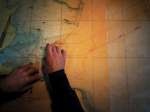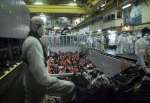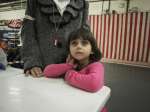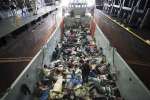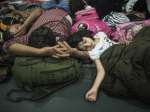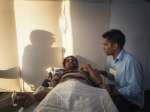Italian coastguard rescues thousands of migrants and refugees in Mediterranean
News Stories, 14 April 2015
GENEVA, April 14 (UNHCR) – The UN refugee agency on Tuesday renewed its call for stepped up rescue operations in the Mediterranean after the Italian Coastguard saved some 8,500 migrants and refugees trying to cross the high seas by irregular routes to Europe from North Africa.
Those rescued since last Friday included an estimated 3,000 people in four boats and 16 dinghies rescued on Monday. At the same time, at least nine people are known to have drowned. These figures are provisional and could rise, as not all the boats have disembarked yet and some are still on their way towards various ports in southern Italy.
The coastguard often requests merchant ships to take part in search-and-rescue operations if all other vessels are being used. On Monday, seven ships travelling towards Libya were asked to help boats in distress and to take those rescued to Sicily. UNHCR has also called for a compensation scheme to alleviate the costs of rescue operations for commercial vessels.
Among those arriving at Palermo early Tuesday was 30-year-old Gebre from Eritrea, who said his boat left Tripoli three days earlier carrying about 400 people. "It was dark and so crowded I could not even move," he said. "After the first night of travel, the boat started taking on water; I have never been so scared. I felt helpless and terrified. Luckily, the Italian Coastguard came shortly after and rescued us all."
Aali, a 21-year-old Libyan from Sirte, said he fled after his brother was killed and his food shop torched by militants. The war changed everything," he said, adding: "Was there really an alternative to this dangerous sea journey?"
UNHCR praised the commitment shown by the Italian authorities in rescuing people in need on the high seas, before renewing an appeal for stepped up rescue efforts and the urgent establishment of a robust European search-and-rescue operation.
This year's toll of dead and missing in the Mediterranean Sea is now well over 500, a number which is 30 times higher than the same period of 2014. These figures show that not enough resources are being used to address the population flows and that, without proper search, rescue and monitoring operations at sea, many more people will die trying to reach safety in Europe.
UNHCR is also calling for legal, safe alternatives for those fleeing conflict and persecution, so that they are not forced to attempt the crossing to Europe by sea.
In the Gulf of Yemen, meanwhile, refugees continue to arrive in Djibouti and Somalia from Yemen, with a total of 1,260 people arriving by boat to both countries over the past two weeks.
All those arriving in Djibouti were Yemeni nationals, aside from three Syrians. The latest new arrivals have fled the intense violence in Aden, whereas earlier waves came mostly from Bab el-Mandeb.
In Djibouti, refugees are registered and receive medical checks and vaccinations before being transferred to a new camp under construction at Markazi, which has 70 tents in place so far.
A total of 915 people, including 156 Yemenis, have arrived across the Gulf of Aden, in Somaliland and Puntland. Recent arrivals to Bossaso port in Puntland have departed from Al Mukalla port in Yemen, and included women and children who arrived extremely thirsty and asking for water.
One woman was heavily pregnant and taken to the Bossaso health centre to deliver her baby. Recent arrivals to Berbera port in Somaliland left Mukha port in Yemen, with other ports closed. The refugees said they paid US$50 per person and that many more people were waiting to depart.
UNHCR and its partners are making contingency plans to receive up to 30,000 refugees in Djibouti and 100,000 in Somalia over the next six months
Inside Yemen, the humanitarian situation continues to deteriorate as conflict spreads. Eighteen out of 22 governorates are now affected by conflict. "Many of the 250,000 mainly Somali refugees in Yemen are also affected by the conflict and we continue to see an increase in people moving from urban areas around Aden to the Kharaz refugee camp, hosting 18,000 people," a spokesperson said.
Meanwhile boats also continue to arrive on the Yemen coast. Last Sunday, 251 people (mainly Ethiopians, but also Somalis) arrived at Mayfa'a. UNHCR partners and staff are registering new arrivals.





